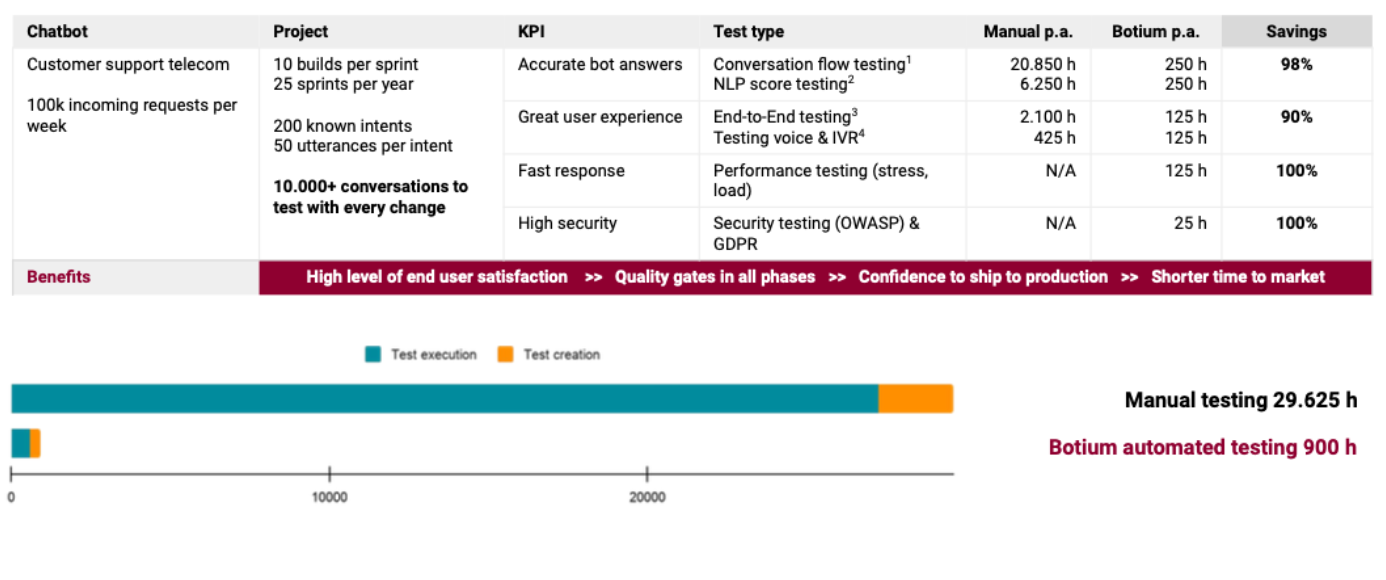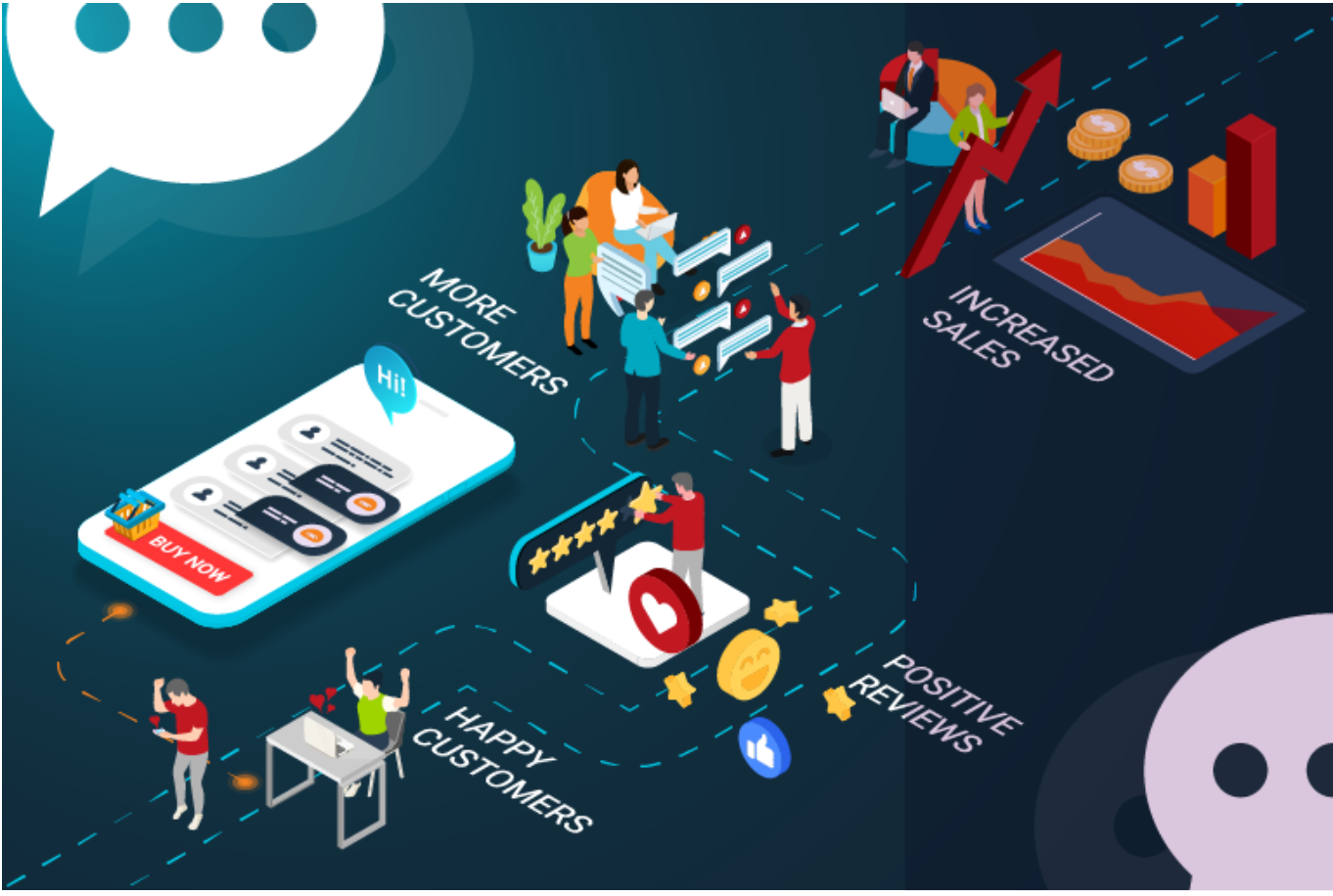Like most people in other technical fields, at Botium we can easily get carried away with what we are currently building, cherishing the tiniest details we carefully thought out and already focusing on future improvements. Our thoughts are constantly revolving around technical jargons and often getting the automatic stigma of being too technical. Although this is a badge we are proud to wear, we never forget the main reason behind our daily efforts.
Eventually, every IT project has the same or rather similar goals:
- – Simplify workflows
- – Save time
- – Reduce costs
- – Increase revenue Chatbot testing is not any different. In this article, we highlight the main business reasons that make automated chatbot testing with Botium an essential and unmissable part of every chatbot project.
Chatbot Testing: the ultimate business overview
User eXperience
No matter what area the chatbot operates in, its main job is to connect and to communicate with people. In most cases these people are customers. The equation of success is actually the same for chatbots as for conventional customer lines: fast and efficient service. Although the technological advancements behind conversational AI are promising, the user experience is still lacking!
Chatbots fail, and even the kindest, or funniest fall-back intent (when the agent doesn’t recognize the end-user expression) can’t save you if the user receives the “sorry, i didn’t understand” message for the third time.
Since ensuring the joy of owning and using a chatbot means covering all requests, businesses account for factors like pleasure, elegance, personality and even fun while designing chatbots. Of course these soft-touches can really place the cherry on top, but in most cases the functionality of the chatbot is deficient.
It won’t be much of a help, if your chatbot “speaks” posh British if the server is down and can not be reached, or it can not handle user requests anymore due to the high load. Start with the basics and then level them up and figure out how they can assist the user through the whole process.
Reputation and Chatbot Testing
While chatbots can help manage your business, they can also be a key tool to maintain and nurture your reputation.
As you might know, customers do not “judge” your company solely based on how you perform in your core activity. Trust is transferable. It is a common assumption to think that the quality of your work in one area will be reflected in others.
Who would want to travel with an airline that needs to maintain hundreds of airbuses a year, but can’t develop a well-functioning chatbot?
As long as consumers feel their expectations have been met, they are likely to return as a customer. Clear conclusion: happy customers leave positive reviews, which in turn, leads to more customers and ultimately increased sales.
It’s clear that a strong online reputation is crucial to obtain, but it can take years to build and only a few minutes to break.
The level of competition is moving
Having a website in 1994, when they started to become available for the general public, was considered something extremely cool and rare to have. Today (regardless of the activity), even the smallest companies can not survive without a transparent website.
Chatbots will go through the same evolution, but with a faster pace. While a couple of years ago, placing a virtual assistant on your landing page or social media was a big step, today they are must-haves. The increasing number of chatbots on the market has moved the competition from the product to the quality level. The question is no longer whether you have a chatbot, but what kind of a chatbot you have.
Chatbot testing improves Return on investment
Chatbots fail. It’s a known issue, but there are not enough actions to avoid it. If we take a look at the global market, only 3% of the big companies that own a chatbot (and could easily afford QA) have automated testing in place for their conversational AI. The other 97% are wasting enormous manpower on manual testing, or don’t even pay attention to quality assurance. However, with this attitude, the primary purpose of chatbot development becomes meaningless. The chatbot can not complete the task in hand and returns the request to the human agent as it would have been without the chatbot anyway. The only difference between the two scenarios is the millions of dollars spent on chatbot development.
Management usually gives priority to IT projects that have revenue growth potential over those that focus mainly on cost savings. Chatbot testing actually falls into both categories, yet it still hasn’t fought it’s well deserved position in the development cycle of most businesses.
Exactly how much money are we talking about?
The following figure shows how the working hours are distributed for manual and Botium automated testing when developing and monitoring an average Telecom customer chatbot.

Chatbot Testing: the ultimate business overview
The outcome in terms of time saved is not less than 28.725 hours a year!
Of course, this is an estimation, since the processes and workflows are different in every business, but the proportions are speaking for themselves. With this information, it is easy to calculate the money that could be saved if you are aware of the average hourly wage of engineers.
Free your employees for better tasks
According to a recent World Economic Forum report, robots, automation, and artificial intelligence could replace 85 million jobs globally by 2025. However, it will also create 97 million new jobs in the future.
Undoubtedly, new phenomena always provoke great enthusiasm, but the general experience is that they do not become exclusive, but are integrated into existing systems and gain space there.
With the advent of Conversational AI, customer service employers can become valuable members of the chatbot development team as business analysts, conversation designers, or test set writers. Breaking out of monotony can greatly increase productivity and the feeling of motivation.
Chatbot Testing: Conclusion
The common perception that customer-service bots are generally less helpful than human representatives can result from the lack of quality assurance. It’s time to put the question on the table: is the money actually saved, that we did not spend on quality assurance, or just had to invest it in something else, such as reputation management after a failed bot. When will our sloppiness backfire and how much will it cost?
Quality is the red ribbon that differentiates us from the competition, leads to customer loyalty and revenue growth. Investing in chatbot testing is letting your customers know that you care about them, their priorities and safety. In addition when quality is a priority for a company, it also sets the tone for the employees. A work culture focused on meeting certain standards is good for everyone!
Botium.ai
